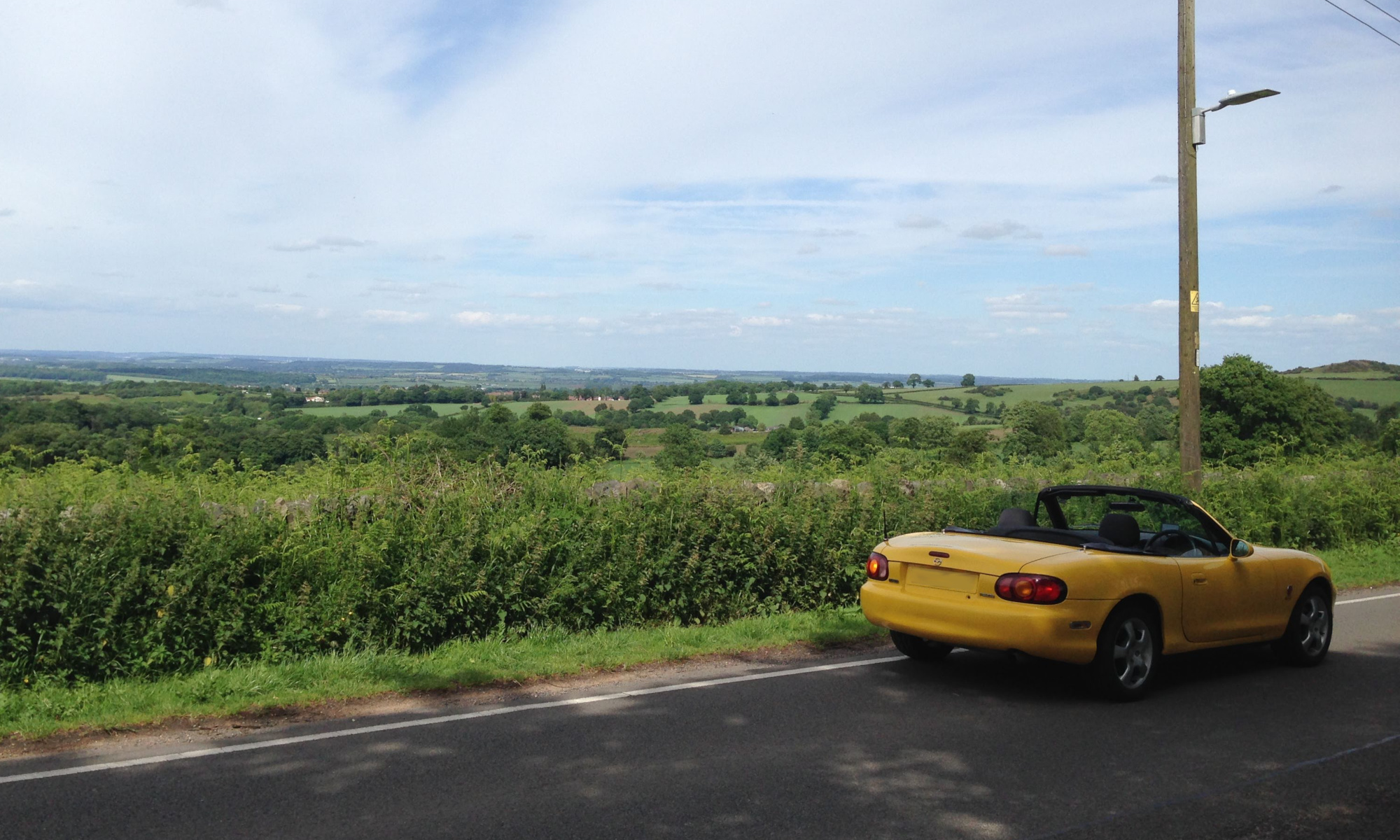Simplified Steady State Vehicle Handling Model – Bicycle Model

| \(\delta\) | steer angle [rad] |
| \(u\) | forward velocity [m/s] |
| \(v\) | lateral velocity [m/s] |
| \(V\) | velocity vector [m/s] |
| \(\beta\) | vehicle slip angle [rad], the angle between the vehicle centreline and the velocity vector at c.g. |
| \(r\) | yaw velocity [rad/s] |
| \(R\) | radius of turn [m], the distance between the turning centre to c.g. |
Assumptions
- No lateral load transfer
- No longitudinal load transfer
- No body rolling and pitching
- Tyres are in the linear range
- Constant forward velocity (specified by the user)
- Steering position is controlled
- No aerodynamic effects
- Rigid chassis and no suspension compliance effects
2 DOF – lateral velocity \(v\) and yaw velocity \(r\)
The steer angle \(\delta\) – input, forward velocity \(u\) specified.
Equations of motion
\[
\left\{
\begin{array}{l}
\mathrm{mV}(\mathrm{r}+\dot{\beta}) &=\mathrm{Y}_{\beta} \beta+\mathrm{Y}_{\mathrm{r}} \mathrm{r}+\mathrm{Y}_{\delta} \delta &= (C_F + C_R)\beta + \dfrac{1}{V}(aC_F \; – bC_R) r + (-C_F) \delta \\
\mathrm{I}_{\mathrm{z}} \dot{\mathrm{r}} &=\mathrm{N}_{\beta} \beta+\mathrm{N}_{\mathrm{r}} \mathrm{r}+\mathrm{N}_{\delta} \delta &= (a C_F \; – b C_R)\beta + \dfrac{1}{V}(a^2C_F + b^2C_R) r + (-a C_F)\delta
\end{array}
\right.
\]
Damping-in-Sideslip Derivative \(Y_\beta = C_F + C_R <0\) Lateral Force/Yaw Coupling Derivative \(Y_r = \dfrac{1}{V}(aC_F – bC_R) \) Control Force Derivative\(Y_\delta = -C_F >0 \) Static Directional Stability Derivative\( N_\beta = a C_F – b C_R \) Yaw Damping Derivative \(N_r = \dfrac{1}{V}(a^2C_F + b^2C_R) <0\) Control Moment Derivative \( N_\delta = -a C_F >0 \)
\(\beta\) and \(r\) are constants. \(\dot{\beta} = \dot{r} = 0\)
Steady-state response (\(\dot{\beta} = \dot{r} = 0\))
| Response to steer angle \(\delta\) (Control) | Response to applied side force \(F_y\) at c.g. | Response to applied yaw moment \(N\) |
| \( \dfrac{1 / R}{\delta} = \dfrac{Y_\beta N_\delta-N_\beta Y_\delta}{VQ} \) | \( \dfrac{1 / R}{F_y} = \; – \dfrac{N_\beta}{VQ} \) | \( \dfrac{1/R}{N} = \dfrac{Y_\beta}{VQ} \) |
| \( \dfrac{r}{\delta} = V \dfrac{1/R}{\delta} = \dfrac{Y_\beta N_\delta – N_\beta Y_\delta}{Q} \) | \( \dfrac{r}{F_y} = \; – \dfrac{N_\beta}{Q}\) | \( \dfrac{r}{N} = \dfrac{Y_\beta}{Q} \) |
| \( \dfrac{V^2/R}{\delta} = \dfrac{V( Y_\beta N_\delta – N_\beta Y_\delta )}{Q} \) | \(\dfrac{V^2/R}{F_y} = \; – \dfrac{VN_\beta}{Q}\) | \( \dfrac{V^2/R}{N} = \dfrac{VY_\beta}{Q}\) |
| \( \dfrac{\beta}{\delta} = \dfrac{Y_\delta N_r – N_\delta (Y_r – mV) }{Q}\) | \( \dfrac{\beta}{F_y} = \dfrac{N_r}{Q}\) | \( \dfrac{\beta}{N} = \; – \dfrac{Y_r – mV}{Q}\) |
path curvature \(1/R\)
yaw angle \(r\)
lateral acceleration \(V^2/R\)
vehicle slip angle \(\beta\)
Distribution of static weight
\[ \dfrac{W_f}{W_r} = \dfrac{b}{a} = \dfrac{Y_f}{Y_r} \] where \(W\) is static weight carried by each axle and \(Y\) is lateral tyre force at each axleAckermann steer angle
\[\delta_{Acker} = \dfrac{l}{R} \]
the geometric steer angle required for a vehicle to follow a turn radius of \(R\) at low speed.
Neutral steer – even when lateral acceleration is present, the car follows the path defined by the Ackermann steer angle.
General steer angle equation
\[
\begin{array}{l} \begin{align}
\delta &= \delta_{Acker} + ( -\alpha_F + \alpha_R) \\
&= \dfrac{l}{R} + ( -\alpha_F + \alpha_R) \\
&= \dfrac{l}{R} + \dfrac{lKV^2}{R}
\end{align} \end{array}
\]
Understeer/Oversteer
| Static directional stability \(N_\beta = a C_F – b C_R \) | Stability factor \(K = \dfrac{m N_\beta}{l (N_\beta Y_\delta – Y_\beta N_\delta)}\) | Static margin \(\text{SM}= \dfrac{d-a}{l}\) | |
| Understeer | \( N_\beta >0 \) | \( K >0 \) | \(\text{SM}>0\), \(\text{NSP}\) situates to the rear of c.g. |
| Neutral steer | \( N_\beta =0 \) | \( K =0 \) | \(\text{SM}=0\) |
| Oversteer | \( N_\beta <0 \) | \( K <0 \) | \(\text{SM}<0\) |
For oversteer, the critical speed \(V_{crit} = \sqrt{-\dfrac{1}{K}}\), and at the speed \(Q = 0 \) and responses diverge.
For understeer, characteristic speed \(V_{char} = \sqrt{\dfrac{1}{K}}\)
Reference
[1] W. Milliken and D. Milliken, Race Car Vehicle Dynamics.
